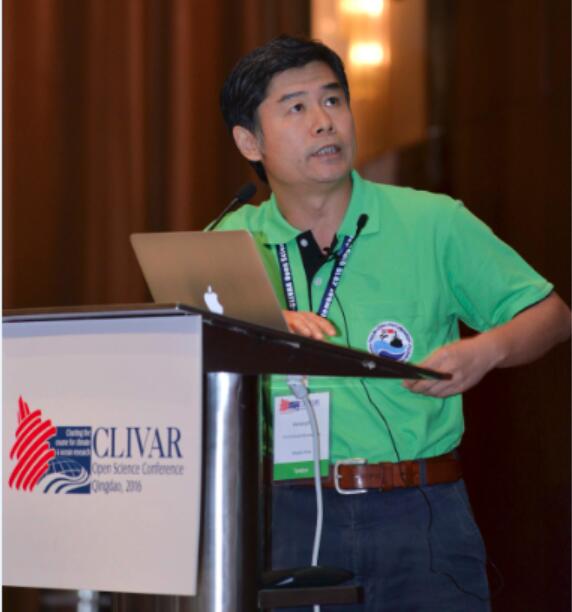CLIVAR OSC: Day 3 Highlights Understanding Ocean and Climate Processes

Rolling into the third day of the conference, participants’ attention was focused on understanding ocean and climate processes. Under this theme, the three sessions were mixing and stirring, ocean and climate dynamics, and upwelling and frontal zones.
Rym Msadeck, CNRS/CERFACS, presented on the role of ocean dynamics in climate variability on interannual to multidecadal timescales. “The ocean is a memory of the climate change and variability,” she said, and because the ocean is globally connected, isolating impacts from one particular basin is difficult. Some of these important connections show how the Atlantic multidecadal variability drives a pattern that projects on the Pacific decadal oscillation. Ocean dynamics play a major role and can modulate the direct climate response to external forcing, both natural and anthropogenic.
Stepping in to talk about mixing and stirring, Jen MacKinnon of Scripps Institution of Oceanography showed results from a mixing process study in the Southern Ocean that used tracers. The tracers showed enhanced mixing due to enhanced turbulence in the Drake Passage. However, because the tracer spent more time near the bottom topography this was not accurate—but resolved by running high-resolution models. She also showed that there were seasonal variations in the mixing.
From the First Institute of Oceanography, Weidong Yu showed biological implications for the upwelling in the East Indian Ocean, specifically impacts on the spawning of Southern Blue Fin Tuna. Indian Ocean eastern boundary upwelling is unique, due to the strong seasonal modulation from the monsoons. There are both local/seasonal variations of the upwelling, and remote/intra-seasonal/interannual variations.
Paulo Calil, Federal University of Rio Grande, showed that subtropical fronts in the South Atlantic are transition zones between the subpolar waters of the Southern Ocean and subtropical gyres. The fronts are the convergence of water masses and have a big signal in biology. There is also evidence for small-scale features associated with mesoscale and submesoscale eddies at these fronts, but observations are scarce. Introduction of passive tracers in the simulation reveal a strong upwelling from submesoscale eddies that will have an impact on the upper ocean processes, particularly related to biology.
“The closer you look at the ocean the smaller the processes you see,“ stated Jen MacKinnon during the evening keynote lecture on multiple scales of ocean dynamics. With increasing resolution comes increasing complexity. She presented an overview of recent activities from a US Climate Process Team that found both the magnitude of the mixing and its vertical profiles are important for climate, since mixing matters where there is stratification to mix against. In addition, impacts involve convolution of many space-time scales that interact nonlinearly, and it isn’t possible to consider any alone. She concluded by saying, “We need more process driven studies to understand how the ocean works,” and encouraged future collaborations in the form of climate process team structures, particularly on the international scale.
Below are some highlights from the parallel sessions.
Mixing and Stirring
- Knowledge about submesoscale impacts on the upper ocean and in the lower ocean is developing, and this impact seems to have consequences in upper and bottom layers of the ocean.
- Observing and modeling evidence is developing on the influence of non-breaking surface waves on upper ocean turbulence, which shapes the ocean mixed layer.
- Internal waves—initiated by tides, wind bursts, etc.—are shown to influence ocean dynamics and mixing. Better understanding is needed for the generation, influence on ocean dynamics and thermodynamics, and impact on climate of these processes.
- Small-scale processes and large-scale ocean dynamics, air-sea interactions, and climate are interconnected. They cannot be summed up as an average of small-scale “processes” as they do not sum up in an average sense.
- Knowledge is needed to better understand the whole spectrum of these small-scale processes and the related process and scales interactions.
Ocean and climate dynamics
- Coupled oceans and atmospheres have global scale interconnections, which has consequences for climate change, rain, drought, and other impacts.
- High resolution sampling and modeling is necessary for understanding internal variability, frontal systems in mid-latitudes, sea surface temperature biases in the Southeast Atlantic, eddy diffusivity parameterization, and the meridional overturning circulation.
- The internal variability of the climate system interacts with the mean state in a variety of ways, such as meridional modes’ dependence on the mean state and the Tropical Pacific response to Arctic sea ice loss.
- Ocean processes matter for successful understanding of internal variability. For example, reflected kelvin waves could influence the initiation of El Nino, the equatorial Pacific response is dependent on ocean circulation, and the Kuroshio-Oyashio current influences air-sea interactions and mid-latitude atmospheric variability.
Upwelling and frontal zones
- The bottom boundary layer in the southern Drake Passage was much thicker (100 m) than previously anticipated (and estimated from California and Oregon coast at 10 m) and was also a strong function of the topography. The core current was ~0.4 m/s near the bottom.
- East Indian Ocean upwelling is closely associated with Indian Ocean dipole events and to a lesser degree, ENSO. ENSO affects the east Indian Ocean upwelling primarily via the atmospheric bridge rather than through the Indian Ocean throughflow.
- In situ observations showed increased upwelling in the eastern boundary systems in the South Pacific, with southward displacement of the southern Pacific high from 2008-2014. This has an effect on fish production, but it’s not clear if it relates to the oxygen minimum zone depth or carbon levels.
- Boundary layer depth can be improved by including the Stokes Shear Force in the Langmuir turbulence parameterization. The Stokes Force influences submesoscale fronts.
- New observations in the Angola Current, as compared to five different ocean reanalysis products, show poor resemblance to the Angola Current seasonality.
- A warm bias is seen in most ocean-coupled models for the Benguela Upwelling System. Finer scale models are needed for eastern boundary current estimates, but there has been no improvement beyond a tenth-degree model. Models are doing a better job at reproducing coastal upwelling, but they have a hard time getting the vertical transport of the curl-driven offshore upwelling.
Participants filled their evening agenda with town halls discussing the just released draft CLIVAR Science Plan, high-resolution model improvement projects, Future Earth, and ocean and climate modeling.
Remember to follow #CLIVAR2016 for live updates from the conference.














Add new comment